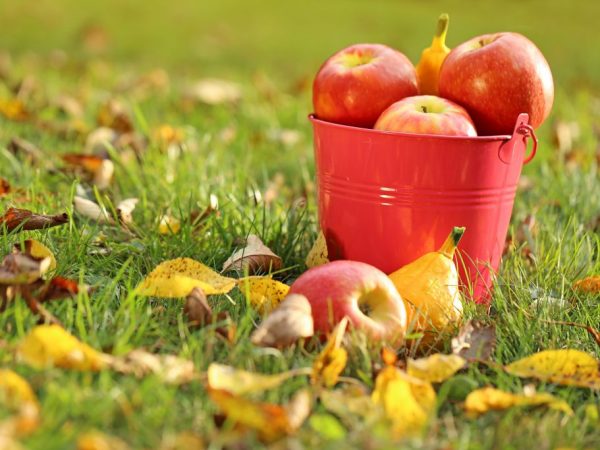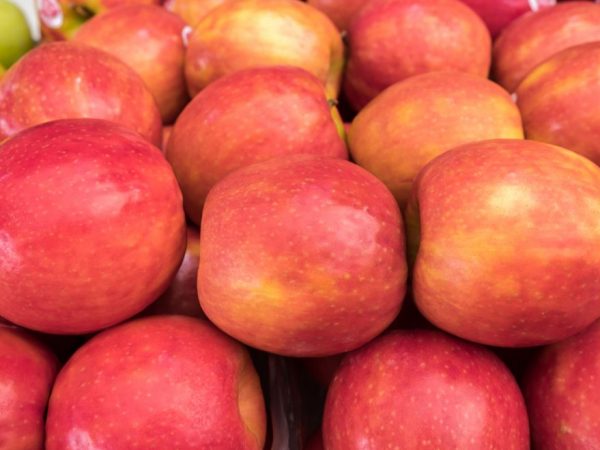Cultivation of an apple tree Arkadik
The Arkadik apple tree was bred by experienced VSTISP breeders in Moscow. They took the Russian Arkada variety and the American SR-0523 as a basis. The author is V.V. Kichini, for breeding his team chose the optimal gene codes and, as a result, got an excellent variety that is suitable for growing in the regions of the Moscow region and central Russia.
- Characteristics of the variety
- Advantages and disadvantages
- Description of the tree and fruit
- Taste
- Yield
- Pollinators
- Winter hardiness
- Disease resistance
- Growing regions
- Landing
- Sapling selection
- Landing dates
- Site preparation and seedlings
- Landing technology
- Care
- Watering
- Top dressing
- Pruning and shaping the crown
- Protection against diseases and pests
- Preparing for winter
- Subspecies and variants
- Gardeners reviews

Cultivation of an apple tree Arkadik
Characteristics of the variety
In terms of its qualities, this apple tree surpasses the Arkad yellow variety and even the famous Antonovka, because the latter often freeze slightly and hardly tolerate wintering.
Advantages and disadvantages
Artificially bred varieties always have an advantage in a number of characteristics, because they are created with the aim of obtaining the maximum possible amount of product at the output with the minimum cost of resources for care.
Advantages:
- high harvest from year to year;
- fruits are large enough, sweet;
- fast growth;
- the possibility of wide zoning;
- scab resistance;
- unpretentious care.
Disadvantages:
- requires timely harvesting, because if you miss the moment of ripeness of the fruits, they begin to crumble and lose their presentation;
- short shelf life;
- a pollinator tree is desirable.
Description of the tree and fruit
After planting, the tree grows quickly with a high level of vitality. Rapid growth is observed before the beginning of the fruiting period, then the rate slows down. Even dwarf varieties and different types of rootstocks have this characteristic. Trees can grow up to 4 m.
The crown is rounded, slightly conical at the top, creates a good shadow. The leaves have a beautiful juicy green color, matte, medium-sized and slightly elongated. On strong branches, thick and at the same time elastic round-shaped shoots with a red tint of the bark are compactly located.
The fruits are found on a large number of annelids. Weight ranges from 120-320 g, i.e. one apple can be 2-3 times larger than the other. The fruit has a rounded oblong shape, elongated from top to bottom.
The skin is thin, whitish-green. When the fruit is just beginning to ripen, a blush appears on one side of it, which gradually turns dark red and covers a fourth of the apple. There are gray subcutaneous dots on the peel.
Taste
It should be noted the taste and benefits of the fruits of this variety. They are juicy, sweet, a slight sourness is almost not felt, which is why children like them so much.
Yield
You can see the first color and taste what apples taste like in the second year, but the amount of fruit will be small. Active flowering with a further high yield level begins in the third year of the tree's life.
Not many varieties have this advantage. Compared to apple trees Papiroyantarnoe and Marat Busurin - twice as fast.
Depending on the growing conditions and the age of the tree, the yield from one tree will be from 150 to 220 kg on average. Cases of harvesting 340 kg of fruits were recorded.
You should start picking apples in mid-August. If you are late, you risk being left without a crop. When choosing this variety for the garden with the further sale of products, keep in mind that the fruits lie for about a month with timely accurate collection and compliance with storage conditions.
Pollinators

The apple tree yields even without pollinators
The tree is self-fertile, which means that even in the absence of a pollinator in the garden, half of the flowers will be ovary. Ideally, plant 2 trees, but you can limit yourself to one and be content with a good harvest.
However, in the presence of pollinating varieties, the number of fruits will be at least 2 times greater. These include any other summer and early autumn apple trees. It is better to choose as a pollinator the one that bears fruit in early autumn and has taste similarities to the Arkadik variety.
Take this issue seriously, because this can negatively affect the taste of the apple tree.
Winter hardiness
The tree is classified as highly winter-resistant. Without consequences for the tree itself, its bark system and even the crop, it can withstand temperatures down to -35 ° C.
The variety can withstand not only frost, but also high temperatures. It tolerates extreme heat and drought, but with little crop loss.
Disease resistance
The description says trees are immune to a number of diseases. Despite its presence, without proper and timely processing of the apple tree, it will not perform its protective functions for long.
As soon as conditions change, stable care or even watering disappears, the tree is stressed and becomes vulnerable to pests.
The apple tree is resistant to many diseases, including scab.
Growing regions
Initially, the variety was bred taking into account the natural and climatic conditions of the Moscow region. It has received its wide distribution outside this area. Gardeners of central Russia choose it for their garden and celebrate its excellent adaptation.
This variety is not suitable for the regions of Siberia and the Urals; late frosts can break the color and harm the tree itself. For these areas, the Arkadik apple tree on a dwarf rootstock is better suited.
Landing
To grow a healthy tree and get a good harvest, you need to choose the right planting material, a place for it and do everything in the right time.
Sapling selection
Saplings 1-3 years old are usually on sale. You should not buy an older tree in order to get a quick harvest.
Pay special attention to the roots: they should not have thickening and damage.
Landing dates
You can plant the Akradik apple tree in autumn and spring. The period from late September to mid-October is the most suitable, and in spring the variety can be sown at the end of April.
Site preparation and seedlings
It is advised to prepare the landing site in advance. This should be preceded by work on clearing the area from weeds and removing debris.
Choose a bright place, the absence of drafts is important.
Planting on a site where another tree has recently grown is unacceptable. A seedling needs a lot of nutrients for rooting and growth, and if you place it in an environment depleted by another crop, the process of adaptation and development will be significantly delayed.
Given the size of the root system of the tree (and they are 2 times larger than the crown), choose the most spacious place.
Landing technology
A planting hole must be dug and prepared in the sequence presented in advance, about a week in advance.
Landing consists of the following stages:
- digging a hole 80x80x70 cm;
- the bottom must be loosened and approvals added there: superphosphate, wood ash or compost mixed with crushed nutshells;
- let it stand for a week, otherwise we risk burning the roots of a young tree;
- after a while, we place the seedling in the center of the pit;
- sprinkle with ordinary earth;
- we form a hole at the trunk;
- watering the tree.
Tip: Drive a peg next to the young tree and tie a seedling to it, this will allow the trunk to grow even and strong.
Care

Requires abundant watering for delicious apples
You should not place high hopes on the harvest if you are not ready to provide tree care. Familiarize yourself with the features of this process, and you will understand that the Arkadik apple variety does not require large expenses.
Watering
Mandatory watering must be done at least 2 times a month during the first year of life. A one-time rate of water is 3-4 buckets.
Top dressing
Feeding should be taken with care. Remember that the fertilizer applied during planting will last for the first year of the tree's life. In the future, it is better to use feeds of organic and mineral origin.
Manure and compost are organic, they are advised to be applied once a year. Nitrogen potash and phosphorus substances, i.e. mineral fertilizers, applied in the fall, after harvest. Calculate your dosage carefully. If you overdo it, the crop will begin to grow faster, and this will weaken the frost resistance in winter.
Pruning and shaping the crown
The first pruning is carried out in the second year. First you need to get rid of dry branches and shoots. If the tree has tolerated wintering well, you can start pruning in early spring. If you doubt the vitality of a young tree, it is best to postpone pruning for another year.
Remove branches that are tangled with each other. The top also needs to be pruned so that the tree will grow in width, not in height. With such a crown, it is easier to harvest and carry out agricultural work.
Active crown formation by pruning occurs in the first years, before the start of active fruiting. Then the rapid growth of branches stops, the main task will be to remove dry and rotten parts.
Protection against diseases and pests
In the early years, it is better to coat the tree trunk with chalk mortar, and then replace it with lime.
You can protect the culture from rodents by wrapping the tree with any material. The most accessible are spruce branches. Parchment or reed will also work.
Preparing for winter
In order for the apple tree to winter well, the soil near the tree is mulched with sawdust or dry grass, and a mound is made from the first snow.
Subspecies and variants
The apple tree of this variety has the following subspecies:
- on a dwarf rootstock: this subspecies is more compact, its height does not exceed 2.5 m, it has the best frost-resistant characteristics;
- columnar: more whimsical to the composition of the soil, but not expanding, which allows it to be planted on a site where the territory is limited;
- summer yellow: this option has smaller fruits and is not resistant to scab, more effort is needed to get the result;
- sugar: does not differ from the Arkadik variety, fruitful (about 200 kg per tree), beautiful fruits - an excellent product for retail;
- pink: has small fruits weighing up to 100 g, low-growing with a low yield.
Gardeners reviews
Gardeners admire this variety and are happy to grow a tree on their site. The main advantage is the taste of apples. Thanks to this, they take pride of place on the table and are excellent for preservation. The main thing is to follow the planting technology and care rules, the apple tree is sensitive to a lack of fertilizers.

